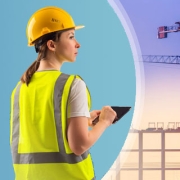Digital processes are transforming construction and introducing new risk considerations. The question is, how should these risks be handled?
As the digital age gains momentum, technology is at the forefront of CEOs’ minds. Indeed, Marsh’s Head of Climate & Sustainability Strategy, Amy Barnes, recently wrote about The risks and rewards of frontier technology.
In 2016, the Farmer Review warned the UK construction industry it would have to “modernise or die”. The 80-page report, written by industry veteran Mark Farmer and commissioned by the UK Government, noted that research and development within the industry was almost non-existent, productivity was low, and cost inflation high. This situation was mirrored in many countries around the world.
In order to modernise and move into the 21st century, the industry has accelerated its uptake of new technologies, including robotics, machine learning and automated planning decisions through digital design. Onsite, hard-hat sensors and driverless vehicles are coming into use, while digital aids such as artificial intelligence (AI), and building information modelling (BIM) are used throughout the duration of a project.
Top tech risks for construction companies
The adoption of new technology can create a wealth of opportunities for construction companies, including improvements in management, information, speed, accuracy, accountability, costs and reduced risk, but it can also bring new risk.
Cyber Risk
New technology often has a cyber element and one of the biggest risks is cyber breaches. It’s estimated that cybercrime costs the UK industry £27 billion a year. Construction output in the UK is more than £110 billion per annum and contributes 7% of GDP, making it a very attractive, wealthy industry to target. As relatively new adoptees to sophisticated technology, construction companies risk leaving themselves at the mercy of a wide range of players, from nefarious state actors intent on disruption or wishing to steal information, to hackers who want to profit by the placement of ransomware and siegeware. Understanding vulnerabilities and installing and maintaining cyber risk protection is imperative.
New technologies being considered by construction companies
BIM
Projects procured by the UK Government now require the use of BIM, which offers a central point of building reference in a 3D digital model. BIM software creates a collaborative design and build process that visualises the physical and functional aspects of a building. BIM enables real-time collaboration on a single platform, and is important to contractors of large projects, for both a visual and quantitative model of the build. It is also useful for materials ordering and scheduling. Taking BIM a step further is the digital twin, which creates a digital replica of a finished, functional building.
How to deal with construction technology risks
For companies looking to adopt new technology, risk management is key. Contractors, owners, and developers should work with trusted advisers to ensure all adequate protocols have been adopted in order to identify, analyse, evaluate, and address cyber security threats. This could include outside organisations that are commissioned to discover weaknesses in cyber security systems. These companies engage in activities such as penetration testing designed to find vulnerabilities in a system before an attacker does. It simulates real-world attacks so companies can identify and fix weaknesses before they’re exploited.
Companies also need to speak to their construction broker to review how it will affect risk allocation and insurance, and ensure the risks are covered under their construction insurance policies.
How to gain optimum insurance terms
The construction insurance market has gone through a transition, moving from a market that experienced stable or declining pricing for over a decade, to one in which prices have been rising — though there has been some moderation from 2021. Underwriters will continue to scrutinise each project in detail as the market remains challenging, seeking detailed risk information for in-depth review.
This is why it is important to engage early with a broker who has expertise in both construction and in wider specialties, including cyber risks, and has the capabilities to respond to the challenging economic and business risks faced by contractors, developers, and owners. With their specific technical and market knowledge, and close relationships with underwriters, experienced brokers are able to expertly navigate periods of tightening insurance markets. Early engagement will ensure the contractual structure reflects the optimal insurance programme design and enable sufficient time to negotiate terms.
Source: Marsh













